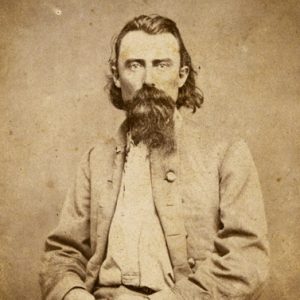calsfoundation@cals.org
Skirmish at Lamb's Plantation
aka: Skirmish at Helena (August 1, 1864)
|
Location: |
|
|
Campaign: |
None |
|
Date: |
August 1, 1864 |
|
Principal Commanders: |
Brigadier General Napoleon B. Buford (US); Brigadier General Joseph O. Shelby (CS) |
|
Forces Engaged: |
Sixth Minnesota Infantry, Thirty-fifth Missouri Infantry, Battery E, Second United States Colored Light Artillery, and unknown number of cavalry (US); Approximately five regiments of cavalry (CS) |
|
Estimated Casualties: |
75 killed (US); unknown (CS) |
|
Result: |
Confederate victory |
Part of the Confederate campaign to disrupt Union operations in eastern Arkansas in the summer of 1864, the Skirmish at Lamb’s Plantation pitted Southern cavalry against freed slaves and Northern civilians. While this was not a major military engagement, the Confederates were successful in their attack and forced many of the families in the area from their land, while tying up Federal troops.
Brigadier General Joseph O. Shelby commanded a brigade of Missouri cavalry in eastern Arkansas during the summer of 1864. Shelby was tasked with gathering recruits for the Southern cause, stopping bands of guerrillas from attacking civilians, and wreaking as much havoc as possible on Union outposts in the area. He tried to avoid a major engagement with Federal forces and instead only attacked targets of opportunity, including the USS Queen City at Clarendon (Monroe County) on June 24, 1864.
Shelby continued to operate in the area and, in late July, sent part of his command to Helena (Phillips County). Other expeditions were launched at the same time by Shelby against Memphis, Tennessee, and the railroad that ran between DeValls Bluff (Prairie County) and present-day North Little Rock (Pulaski County). Several Federal plantations operated in the Helena area and were worked by freed slaves and white Northerners who held the lease to the land. Some freedmen also held leases to plantations and worked their own farms. These plantations were a ripe target for Shelby and his men. By attacking these farms, Shelby could disrupt the entire Federal plantation experiment and tie up Union troops at the same time.
With these goals in mind, the Confederates first attacked plantations in the area on August 1, 1864. Troops under the command of Colonel Archibald Dobbins destroyed at least three plantations that day, including the land belonging to the Lamb family, whose name became attached to the skirmish. Approximately 300 former slaves and 200 mules were captured, as well as large amounts of clothing and other goods. Shelby later reported that around seventy-five Black soldiers, slaves, and white Federals were also killed in the action. Confederate losses were not reported. Brigadier General Napoleon B. Buford dispatched a unit of Union cavalry in pursuit of the raiders, but the Federals were greatly outnumbered and did not attack. The Confederate forces then withdrew from the area.
The attack against the Federal plantations severely disrupted their production levels as the remaining laborers fled the area and the Confederates captured all of the available livestock and tools. Some of the freed slaves who operated leases in the area sold out and departed. While not a large action, the Skirmish at Lamb’s Plantation, and others at nearby farms, did have a detrimental impact on Federal policy and impeded the return to production of the rich farmland around Helena.
For additional information:
TheWar of the Rebellion: A Compilation of the Official Records of the Union and Confederate Armies. Series 1, Vol. 41. Washington DC: Government Printing Office, 1893.
David Sesser
Henderson State University
 Civil War Timeline
Civil War Timeline ACWSC Logo
ACWSC Logo  Napoleon Buford
Napoleon Buford  Joseph Shelby
Joseph Shelby 



Comments
No comments on this entry yet.